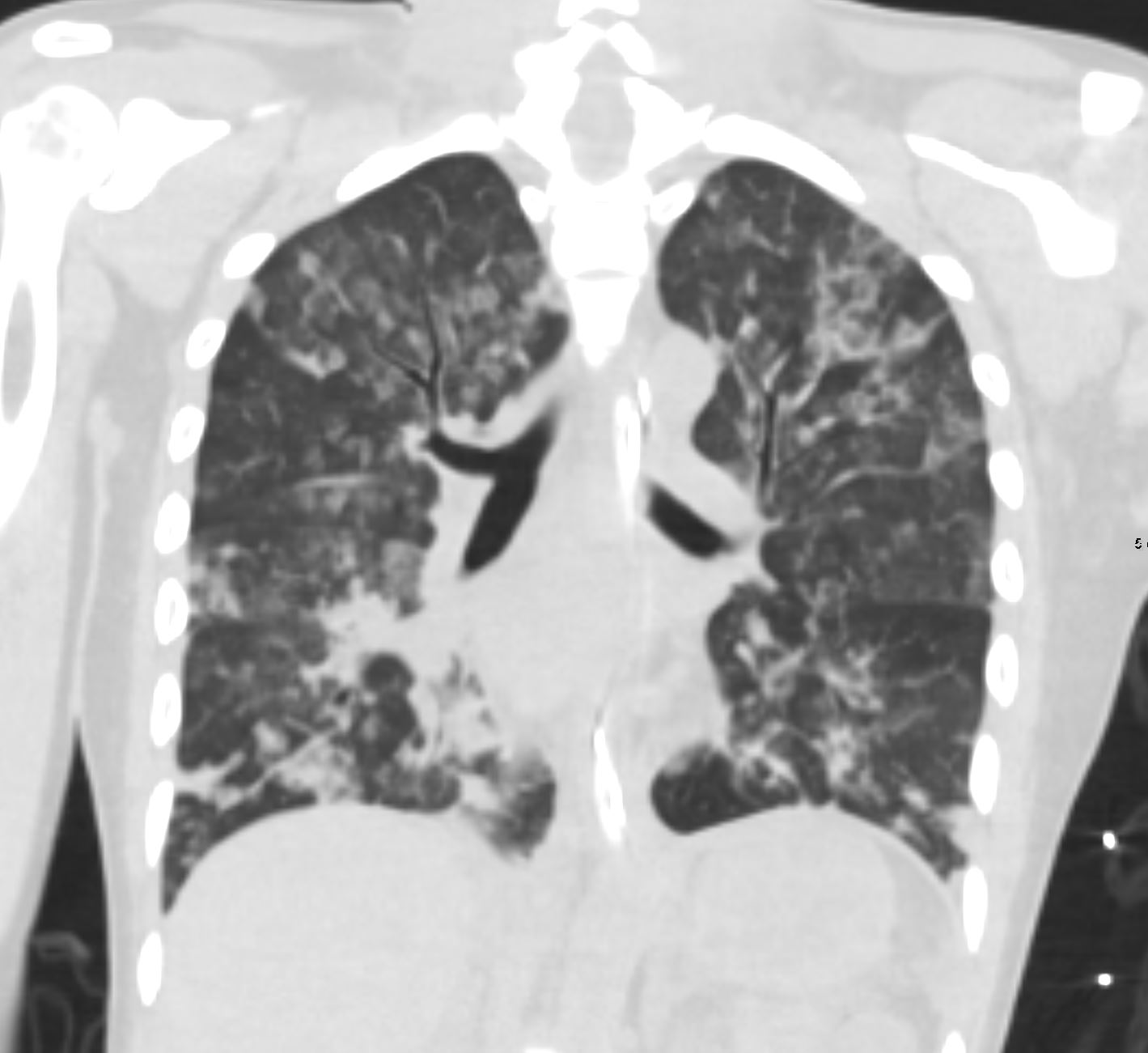Acinar shadows or nodules refer to radiological findings that reflect abnormal opacities in the acinar region of the lungs, corresponding to the respiratory bronchioles, alveolar ducts, and alveoli. These are often small, rounded, ill-defined opacities seen on chest X-ray (CXR) and more clearly characterized on CT scans.

Coronal CT following trauma and resuscitative attempts in a 37 year old female shows 2-5mm solid and ground glass nodules in both the upper and lower lobes with confluence to form subsegmental foci of consolidation in the right lower lobe and right middle lobe. There is evidence of subpleural sparing with a more central distribution. These findings are consistent with hemorrhagic foci of acinar shadows or acinar nodules following trauma
Ashley Davidoff MD TheCommonVein.net 137270 key words .lungs GGO ground glass opacities acinar shadows hemorrhage contusion post resuscitation 37F
Radiological Features
- Chest X-Ray (CXR):
- Appearance:
- Small, ill-defined nodular opacities (2-5 mm).
- May appear clustered or confluent, forming larger areas of opacity.
- Distribution:
- Often diffuse or localized to specific regions depending on the underlying cause.
- Commonly seen in the perihilar, middle, or lower lung zones.
- Airspace Features:
- May resemble consolidation if confluent, with indistinct borders.
- Appearance:
- CT (High-Resolution CT – HRCT):
- Appearance:
- Better delineation of acinar nodules as discrete, small round or polygonal opacities.
- Often associated with ground-glass opacities or consolidation.
- Distribution:
- Centrilobular: Nodules centered around the bronchioles.
- Random: Scattered without a specific pattern.
- Air Bronchograms:
- Visible airways within opacified regions if extensive acinar involvement.
- Clustered Nodules:
- Nodules may coalesce, giving a patchy appearance.
- Appearance:
Characteristic Patterns on Imaging
- CXR:
- “Bat-Wing” Pattern:
- Seen in pulmonary edema where acinar shadows cluster around the hilar regions.
- “Cotton Wool” Appearance:
- Describes fluffy, ill-defined nodules (e.g., in infections or organizing pneumonia).
- “Bat-Wing” Pattern:
- CT:
- Tree-in-Bud Pattern:
- Small acinar nodules connected by branching structures, often seen in infections like tuberculosis or bronchopneumonia.
- Ground-Glass Halo:
- Acinar nodules surrounded by ground-glass opacity, suggestive of hemorrhage or fungal infections.
- Tree-in-Bud Pattern:
Differential Diagnosis
Acinar nodules or shadows can result from diseases affecting the alveoli, airspaces, or small airways. Common causes include:
- Infectious Diseases:
- Bacterial Pneumonia:
- Patchy acinar consolidation or nodules in a lobar or segmental distribution.
- Tuberculosis:
- Acinar nodules with a centrilobular distribution.
- Fungal Infections:
- Nodules with surrounding ground-glass halo (e.g., invasive aspergillosis).
- Viral Pneumonia:
- Diffuse ground-glass opacities with acinar nodules.
- Bacterial Pneumonia:
- Inflammatory/Immune Disorders:
- Organizing Pneumonia:
- Patchy, subpleural or peribronchial acinar nodules with surrounding ground-glass opacities.
- Hypersensitivity Pneumonitis:
- Centrilobular acinar nodules with ground-glass opacities.
- Organizing Pneumonia:
- Vascular Disorders:
- Pulmonary Hemorrhage:
- Ill-defined acinar nodules due to alveolar filling with blood.
- Septic Emboli:
- Randomly distributed nodules, sometimes cavitating.
- Pulmonary Hemorrhage:
- Neoplastic:
- Lymphangitic Carcinomatosis:
- Ill-defined nodular opacities along interlobular septa and acinar regions.
- Lymphangitic Carcinomatosis:
- Other Causes:
- Pulmonary Edema:
- Diffuse ill-defined acinar nodules in a perihilar distribution.
- Pulmonary Alveolar Proteinosis:
- Ground-glass opacities with superimposed acinar nodules.
- Pulmonary Edema:
Clinical Correlation
The diagnosis of acinar nodules requires correlation with clinical features:
- Acute symptoms: Suggest infection or edema.
- Chronic symptoms: May indicate neoplastic or inflammatory conditions.
- Systemic signs: Help differentiate vascular or autoimmune causes
